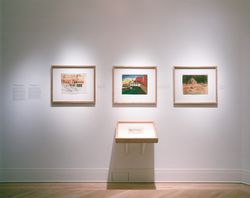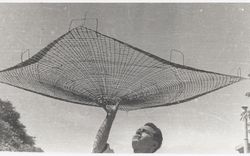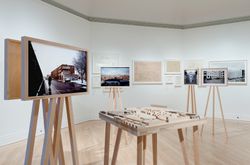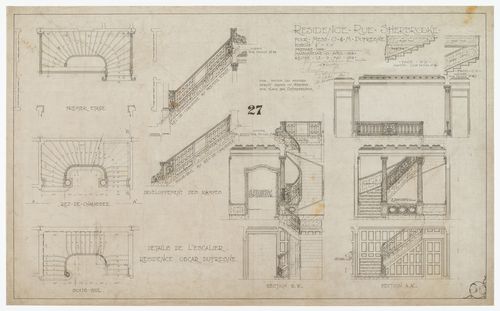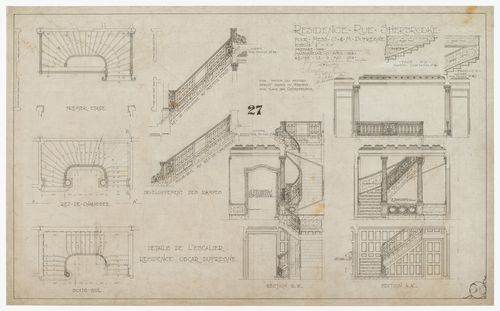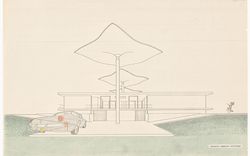archives
Level of archival description:
Fonds
Melvin Charney fonds
AP041
Synopsis:
The Melvin Charney fonds documents Charney's career from the 1950s to the 2012 over 70 architectural and artistics projects, records related to exhibitions he designed, exhibition in which his projects were presented, his teaching activities, and his writings. The fonds contains a considerable amount of textual records, architectural drawings, photographic materials, some models, and a small number of artefacts related to his projects.
1947-2012
Melvin Charney fonds
Actions:
AP041
Synopsis:
The Melvin Charney fonds documents Charney's career from the 1950s to the 2012 over 70 architectural and artistics projects, records related to exhibitions he designed, exhibition in which his projects were presented, his teaching activities, and his writings. The fonds contains a considerable amount of textual records, architectural drawings, photographic materials, some models, and a small number of artefacts related to his projects.
archives
Level of archival description:
Fonds
1947-2012
A look at Louis Kahn’s graphic work shows that his search for abstract monumentality, which culminated in his works of the 1960s, began decades earlier in his abundant drawings, travel sketches, and landscapes. The studies, travel sketches, and landscapes shown in the exhibition—such as Kahns intimate landscapes from Gaspé, where he regularly vacationed during the 1930s(...)
Octagonal gallery
19 May 1993 to 29 August 1993
An Architectural Odyssey: The Travel Sketches of Louis I. Kahn
Actions:
Description:
A look at Louis Kahn’s graphic work shows that his search for abstract monumentality, which culminated in his works of the 1960s, began decades earlier in his abundant drawings, travel sketches, and landscapes. The studies, travel sketches, and landscapes shown in the exhibition—such as Kahns intimate landscapes from Gaspé, where he regularly vacationed during the 1930s(...)
Octagonal gallery
Project
AP148.S1.1967.PR01
Description:
This project series documents Poli's contribution to the competition entry for the restoration of a 16th century fort in Florence, the Fortezza da Bassa and its transformation into a National Centre for Arts and Crafts. This competition design was a Superstudio project led by Adolfo Natalini, reflecting the group's interest at the time in architecture on a "monumental' scale" (Lang and Menking, 2003, 100). Project material consists of study sketches in coloured pencil and graphite, many with annotations, and a page of typed notes, also with smaller sketches. Poli's sketches and notes seem to focus on designs for the entrance to the fort -- "ingresso alla Fortezza" -- and the movement of spectators into the fort. The typed notes and some sketches suggest the idea of a pinball machine with flippers and multi coloured lights lighting up a path.
1967-1968
Competition Fortezza da Basso, National Centre for Arts and Crafts, Florence, Italy (1967)
Actions:
AP148.S1.1967.PR01
Description:
This project series documents Poli's contribution to the competition entry for the restoration of a 16th century fort in Florence, the Fortezza da Bassa and its transformation into a National Centre for Arts and Crafts. This competition design was a Superstudio project led by Adolfo Natalini, reflecting the group's interest at the time in architecture on a "monumental' scale" (Lang and Menking, 2003, 100). Project material consists of study sketches in coloured pencil and graphite, many with annotations, and a page of typed notes, also with smaller sketches. Poli's sketches and notes seem to focus on designs for the entrance to the fort -- "ingresso alla Fortezza" -- and the movement of spectators into the fort. The typed notes and some sketches suggest the idea of a pinball machine with flippers and multi coloured lights lighting up a path.
Project
1967-1968
articles
Domestic Monument
Domestic Monument
Mauricio Pezo and Sofia von Ellrichshausen reflect on the Amancio Williams archive
Actions:
Wohnhaus Schlesisches Tor—also known as Bonjour Tristesse—in Berlin and Punt en Komma in The Hague are Álvaro Siza’s first built works outside his native Portugal. The two projects resemble one another in size, scale, program, and ambition: both were built in the 1980s, both are results of a distinct attitude towards the city, and both were social housing projects(...)
Octagonal gallery Keyword(s):
Álvaro Siza, Punt en Komma, The Hague, Bonjour Tristesse, Berlin
24 September 2015 to 22 May 2016
Corner, Block, Neighbourhood, Cities. Álvaro Siza in Berlin and The Hague
Actions:
Description:
Wohnhaus Schlesisches Tor—also known as Bonjour Tristesse—in Berlin and Punt en Komma in The Hague are Álvaro Siza’s first built works outside his native Portugal. The two projects resemble one another in size, scale, program, and ambition: both were built in the 1980s, both are results of a distinct attitude towards the city, and both were social housing projects(...)
Octagonal gallery Keyword(s):
Álvaro Siza, Punt en Komma, The Hague, Bonjour Tristesse, Berlin
Project
Un dictionnaire
AP041.S1.1970.D2
Description:
UN DICTIONNAIRE consists of black and white photographs of wire-service newspaper articles selected by Charney for their depiction of “people and buildings caught in upheavals”. Charney described these images as “monuments which are created by events outside the confines of architectural institutions”, meaning that buildings and locations assume a “monumental connotation” when they become associated with a significant event. UN DICTIONNAIRE consists of 300 plates, each plate a photograph that “traces the contours of relations which affect our grasp of the significance of buildings”. UN DICTIONNAIRE was presented as an installation at Galerie Catherine & Stéphane de Beyrie in Paris in 1994 and at the Canadian Pavilion of the 7th International Architectural Exhibition in Venice in 2000 as well as at Musée d'art contemporain de Montréal in 2001-2002. The publication “Tracking images : Melvin Charney, un dictionnaire...” related to this project was also realized in collaboration the Canadian Centre for Architecture in 2000. This project series contains correspondence, notes, photographs, installations plans and exhibition space plans related for the aforementioned exhibitions in Paris, at the Venice Biennale and in Montréal. It also contains reprints of panels shown outside the Canadian Pavilion at the Venice Biennale. Source: Montréal : Musée d’art contemporain. (1979) Melvin Charney: Oeuvres 1970-1979. (p. 21-28)
1970-2001
Un dictionnaire
Actions:
AP041.S1.1970.D2
Description:
UN DICTIONNAIRE consists of black and white photographs of wire-service newspaper articles selected by Charney for their depiction of “people and buildings caught in upheavals”. Charney described these images as “monuments which are created by events outside the confines of architectural institutions”, meaning that buildings and locations assume a “monumental connotation” when they become associated with a significant event. UN DICTIONNAIRE consists of 300 plates, each plate a photograph that “traces the contours of relations which affect our grasp of the significance of buildings”. UN DICTIONNAIRE was presented as an installation at Galerie Catherine & Stéphane de Beyrie in Paris in 1994 and at the Canadian Pavilion of the 7th International Architectural Exhibition in Venice in 2000 as well as at Musée d'art contemporain de Montréal in 2001-2002. The publication “Tracking images : Melvin Charney, un dictionnaire...” related to this project was also realized in collaboration the Canadian Centre for Architecture in 2000. This project series contains correspondence, notes, photographs, installations plans and exhibition space plans related for the aforementioned exhibitions in Paris, at the Venice Biennale and in Montréal. It also contains reprints of panels shown outside the Canadian Pavilion at the Venice Biennale. Source: Montréal : Musée d’art contemporain. (1979) Melvin Charney: Oeuvres 1970-1979. (p. 21-28)
Project
1970-2001
Project
AP164.S1.1997.D12
Description:
The subseries documents the show-event base “Fabricaciones / Fabrications,” held at the Museu d'Art Contemporani de Barcelona (MACBA) (February 10th to April 20th, 1998). The firm identified this project as number 110. “Fabrications was an innovative exhibition on architecture conceived and produced jointly by MACBA, MoMA, the Wexner Center for the Arts and the San Francisco Museum of Modern Art. The exhibition presented sixteen life-size architectural interventions, four at each participating center, each produced by a team of architects who explored tectonic issues in a broad sense. The four installations presented at Plaça dels Àngels – the square in front of the MACBA building – explored and modified the surfaces that defined this public space. Vicente Gualla (Barcelona) created an intervention on the façade opposite the Museum, which drew attention to the occupation and the population density that was absent from the buildings in the square. Abalos & Herreros (Madrid) acted upon the façade of the MACBA building itself, cladding and decorating its most monumental elements: the tower and the balcony. Riegler Riewe (Graz) worked with the whole of the square, inscribing a broken horizontal line along the perimeter of the public space. Finally, MVRDV (Rotterdam) acted upon the paving through an evocation of a series of different kinds of sports grounds.” (MACBA website) Documenting the exhibition are design development drawings, correspondence, project descriptions, budgets, notes, and reference, graphic and photographic materials.
1996-2002
MACBA [Museu d'Art Contemporani de Barcelona] (1997)
Actions:
AP164.S1.1997.D12
Description:
The subseries documents the show-event base “Fabricaciones / Fabrications,” held at the Museu d'Art Contemporani de Barcelona (MACBA) (February 10th to April 20th, 1998). The firm identified this project as number 110. “Fabrications was an innovative exhibition on architecture conceived and produced jointly by MACBA, MoMA, the Wexner Center for the Arts and the San Francisco Museum of Modern Art. The exhibition presented sixteen life-size architectural interventions, four at each participating center, each produced by a team of architects who explored tectonic issues in a broad sense. The four installations presented at Plaça dels Àngels – the square in front of the MACBA building – explored and modified the surfaces that defined this public space. Vicente Gualla (Barcelona) created an intervention on the façade opposite the Museum, which drew attention to the occupation and the population density that was absent from the buildings in the square. Abalos & Herreros (Madrid) acted upon the façade of the MACBA building itself, cladding and decorating its most monumental elements: the tower and the balcony. Riegler Riewe (Graz) worked with the whole of the square, inscribing a broken horizontal line along the perimeter of the public space. Finally, MVRDV (Rotterdam) acted upon the paving through an evocation of a series of different kinds of sports grounds.” (MACBA website) Documenting the exhibition are design development drawings, correspondence, project descriptions, budgets, notes, and reference, graphic and photographic materials.
Project
1996-2002
Résidence pour Oscar et Marius Dufresne, rue Sherbrooke, Montréal, Québec : détails de l’escalier
ARCH177651
Description:
Détail de l'escalier monumental, résidence O.D.
21 avril 1916, révision 3 mai 1916
Résidence pour Oscar et Marius Dufresne, rue Sherbrooke, Montréal, Québec : détails de l’escalier
Actions:
ARCH177651
Description:
Détail de l'escalier monumental, résidence O.D.
ARCH285248
Description:
Détail de l'escalier monumental, résidence O.D.
21 avril 1916, révision 3 mai 1916
Résidence pour Oscar et Marius Dufresne, rue Sherbrooke, Montréal, Québec : détails de l’escalier, résidence Oscar Dufresne
Actions:
ARCH285248
Description:
Détail de l'escalier monumental, résidence O.D.
articles
An Umbrella Can Also Be a House
A selection of drawings of the Casa Desmarás by Amancio Williams
Actions:
